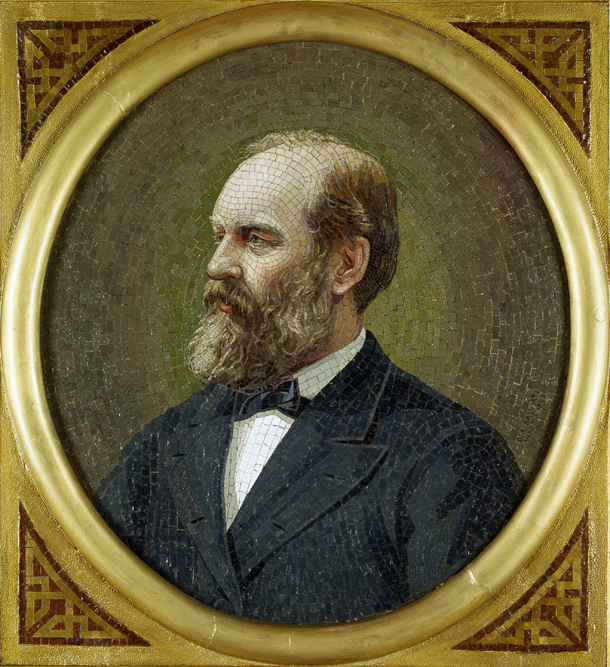
| Title | James A. Garfield |
| Artist/Maker | Salviati, Burke & Co. |
| Date | 1882 |
| Medium | Enamel mosaic |
| Dimensions | h. 25 x w. 23 in. (h. 63.5 x w. 58.4 cm) |
| Credit Line | U.S. Senate Collection |
| Accession Number | 39.00002.000 |
In 1883, a Tiffany and Company representative wrote to Secretary of State Frederick T. Frelinghuysen on behalf of Antonio Salviati, a well-known Venetian manufacturer of mosaics and art glass. The letter stated that Messrs. Dr. Salviati, Burke, & Co. wished to donate a specially made memorial mosaic portrait of President James A. Garfield to the United States. The portrait of the recently assassinated president had been designed as a companion piece to a memorial mosaic portrait of President Abraham Lincoln, which Salviati gave to Congress in 1866. Following temporary exhibition in Boston at an arts and industries fair, the portrait of Garfield was formally accepted by a concurrent resolution in May 1884.
Salviati, whose manufacturing companies were largely responsible for the rebirth of Venetian glasswork during the late 1800s, created mosaics in a medieval style that found favor among designers of buildings and memorials. In London, Salviati's mosaic murals were installed in the Albert Memorial and in the cupola of St. Paul's Cathedral. In the United States, Salviati mosaics decorate the church and the museum on the campus of Stanford University in California.
A U.S. representative from Ohio and 20th president of the United States, James Abram Garfield was born near Orange, Ohio. Before entering political life, Garfield was a professor at Western Reserve Eclectic Institute (now Hiram College) and served as its president from 1857 to 1861. Elected to the Ohio senate as a Republican in 1859, he gained popularity as a persuasive speaker in support of abolition. During the Civil War, Garfield joined the Union army, performed courageously in battle, and rose to the rank of major general before resigning in 1863. He then served in the U.S. House of Representatives from 1863 to 1880. An opponent of currency inflation and excessive tariffs, Garfield was chosen House minority leader in 1876. The following year he played a key role in the election of President Rutherford B. Hayes by serving on the electoral commission that ruled on contested ballots from several states.
Although elected to the U.S. Senate in 1880, Garfield never took his seat. Following a lengthy deadlock at the Republican convention, he was unanimously nominated for the presidency as a compromise candidate. He won the election but served as president for only four months. Garfield was fatally shot at the Pennsylvania Railroad depot in Washington, D.C., by Charles Guiteau, a disappointed office seeker. Public outrage over the loss of President Garfield, who lingered for 11 weeks before dying, led to the creation of the Civil Service system to manage U.S. government employment more effectively.